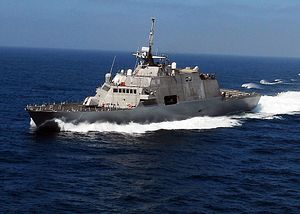U.S. officials have indicated that the U.S. Navy will conduct freedom of navigation patrols near China’s artificial islands in the Spratly Islands in the South China Sea, Foreign Policy reports. The proposal to stage these operations has been under consideration for some time. During the summer, reports emerged that the White House and the Department of Defense disagreed on the need to stage freedom of navigation patrols, with the White House allegedly against the proposal while the Pentagon strongly favored it.
The White House’s cautious approach was ostensibly a result of wanting to avoid harmful diplomatic fallout ahead of Chinese President Xi Jinping’s inaugural state visit to the United States, which took place in late September. With Xi’s visit now behind it, the Obama administration can assert freedom of navigation and overflight around China’s artificial islands for an arguably more manageable diplomatic cost. Additionally, recent reports that Chinese naval ships conducted “innocent passage” through U.S. territorial waters off the Aleutian Islands off the coast of Alaska provides somewhat of a tit-for-tat rationale for these operations.
The Foreign Policy report notes that officials have not yet made a final decision, but all signs point to a consensus now on using U.S. military assets to assert the United States’ understanding of the status of these maritime features in the South China Sea under international law. As my colleague Shannon Tiezzi clarified recently, it is misleading to claim that by conducting these freedom of navigation patrols, the United States is challenging Chinese sovereignty claims over the entire Spratly Islands:
If United States decides to conduct these patrols, it will not be challenging China’s sovereignty claims over the Spratly Islands writ large. The U.S. has repeatedly state that it takes no position on the sovereignty of the disputed features in the South China Sea. Rather, by conducting patrols within 12 nm of some of China’s artificial islands, Washington would be providing a public assertion of the American interpretation of international law (specifically the UN Convention on the Law of the Sea) regarding freedom of navigation.
Over at the Center for Strategic and International Studies’ Asia Maritime Transparency Initiative, James Kraska outlines the legal rationale for the United States to exercise its right to freely navigate waters with 12 nautical miles of these South China Sea island features. Under the 1982 United Nations Convention for the Law of the Sea, “Artificial islands, installations and structures do not possess the status of islands.” Indeed, the status of the features where Beijing has carried out so-called “reclamation” work is at the heart of the Philippines’ case against China at the Permanent Court of Arbitration (PCA) in The Hague.
Though the PCA will make the final call on these features, provided it decides it has jurisdiction over the case to begin with, the Philippines government, in evidence submitted to the court based on geological and hydrographic surveys, claims that Gaven, Hughes, Subi, and Mischief reefs are what are known as “low-tide elevations” (maritime features that do not appear over the surface of the sea at high-tide), and Cuarteron, Fiery Cross, and Johnson reefs are “rocks” (a feature which “cannot sustain human habitation or economic life of its own”). “Rocks” cannot generate an exclusive economic zone under UNCLOS, and are entitled to just a 12 nautical mile territorial sea. Islands, meanwhile, can generate EEZs. When outside of a state’s EEZ, artificial islands and installations, such as oil rigs, are entitled 500 meter safety zones under UNCLOS. In the South China Sea, specifically in the Spratlys, the ownership and sovereignty of these features is under question and the United States continues to take no position on the issue.
In narrow terms, freedom of navigation operations within 12 nautical miles of China’s artificially built islands–certainly Subi and Mischief which were unambiguously low-tide elevations in their “pre-reclamation” state–would reject China’s claim to any sovereign authority around these features.
When we’ll see these operations begin is still up in the air, but it should be reassuring to U.S. allies and partners in the region that the debate in Washington has shifted from a matter of “if” to “when.” Another question that remains is whether U.S. partners and allies in the region will send their military assets to join the United States in these patrols. Though China would undoubtedly see this as a highly provocative move, it would display real consensus and disapproval of how Beijing has chosen to pursue its interests and claims in the South China Sea.
































